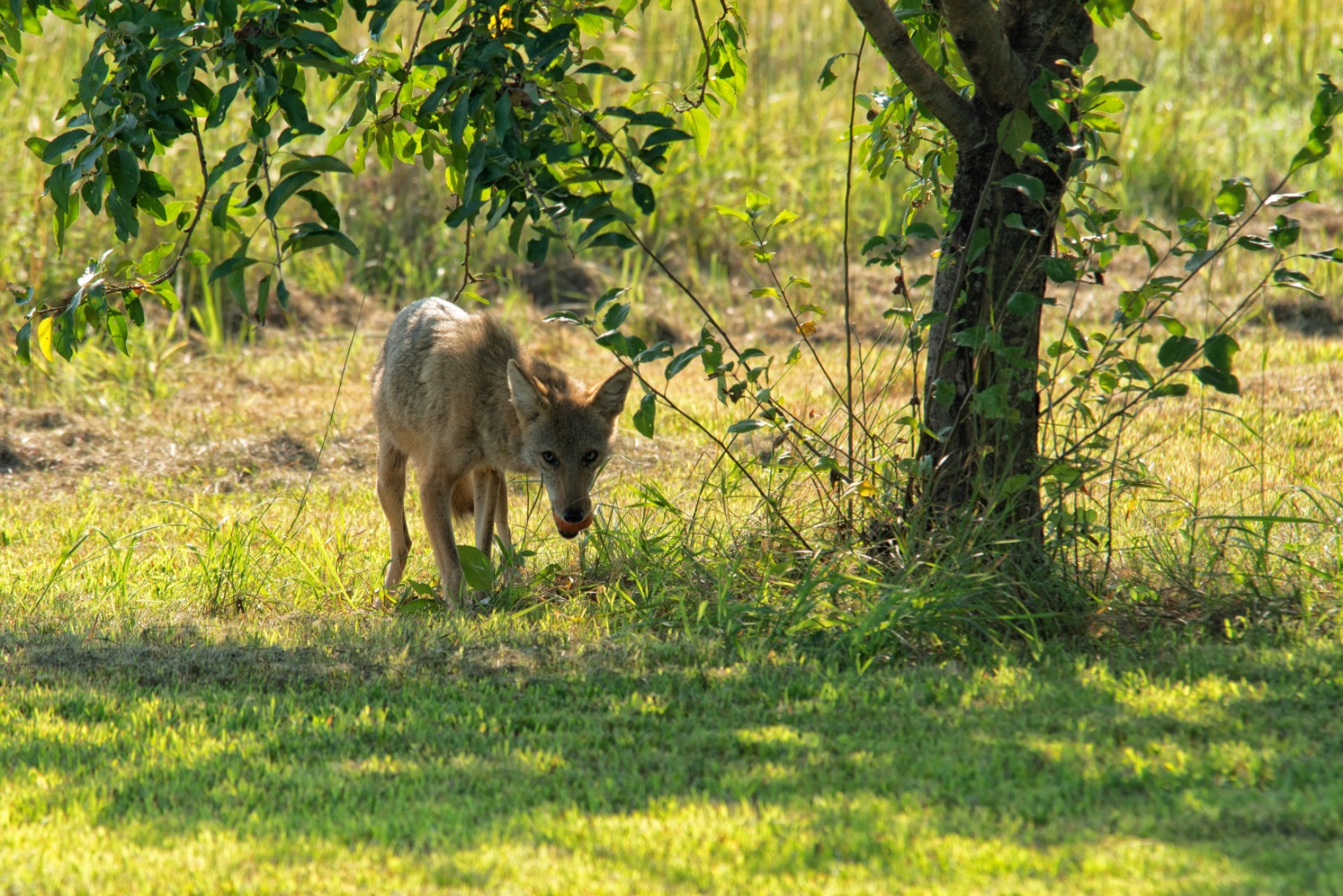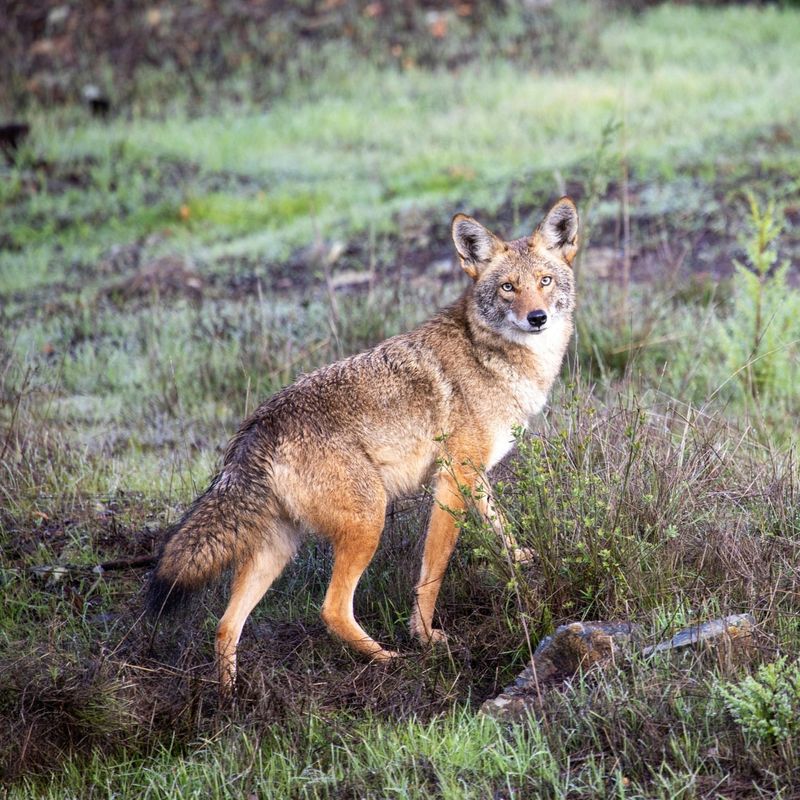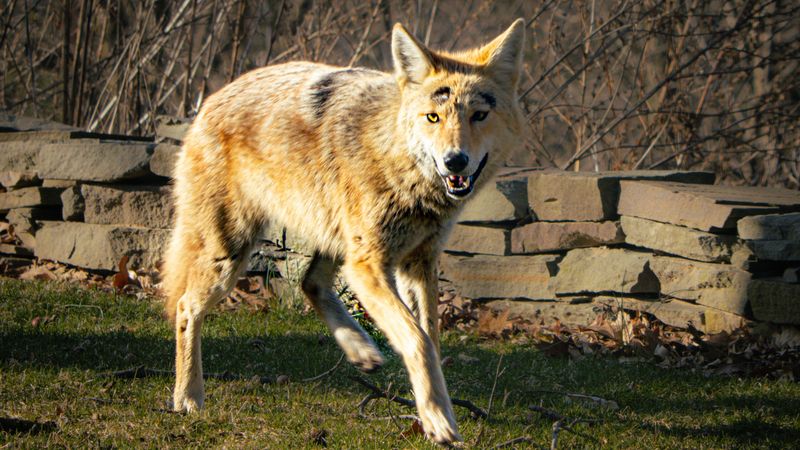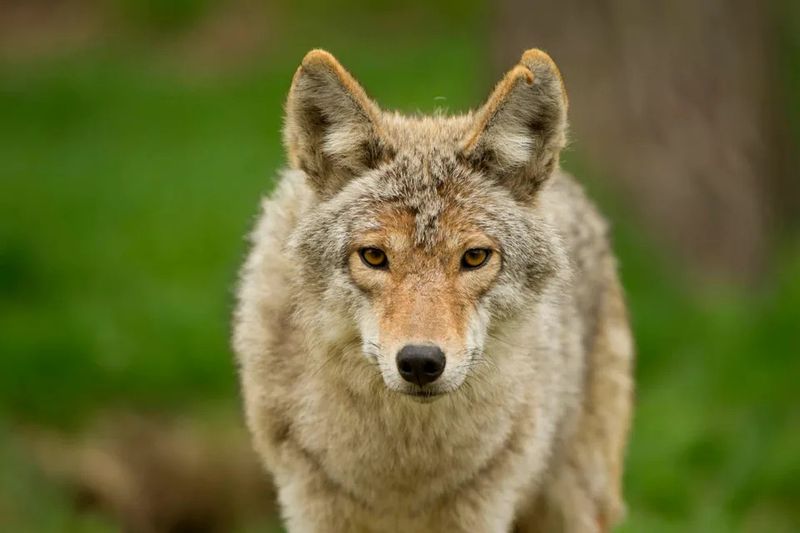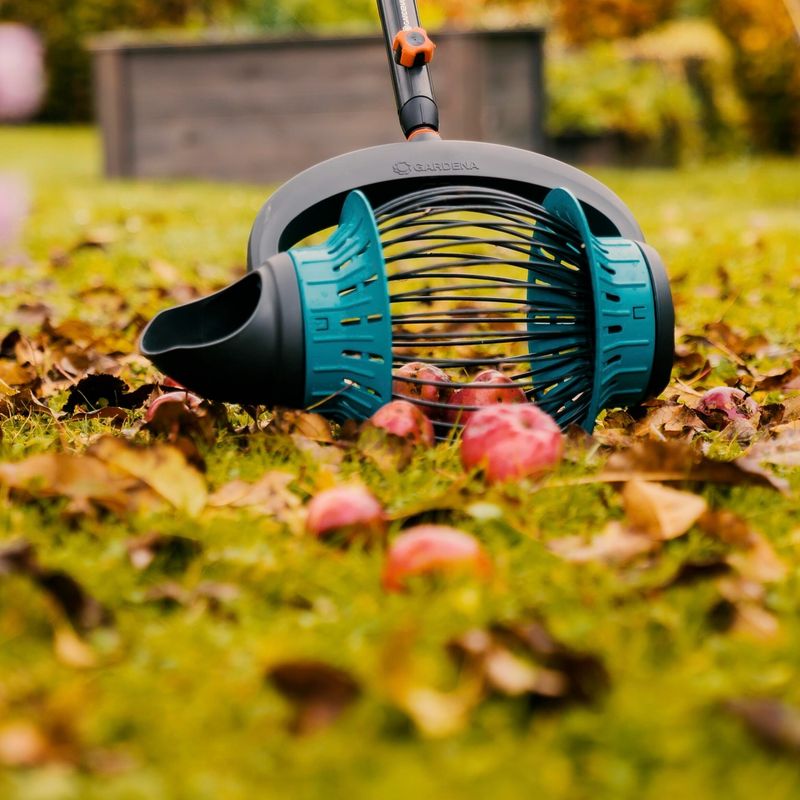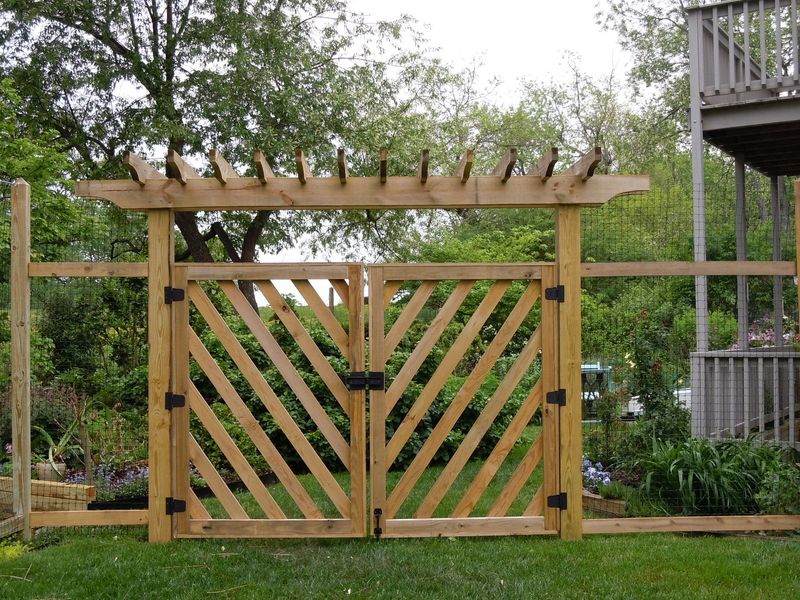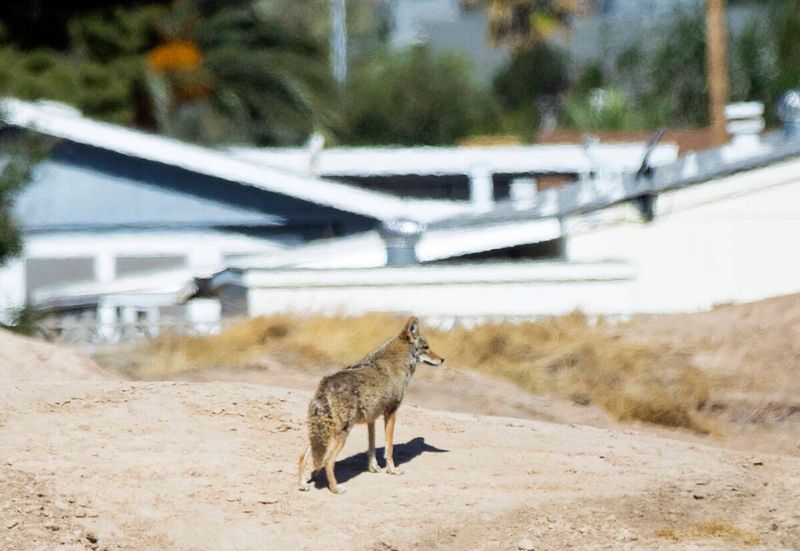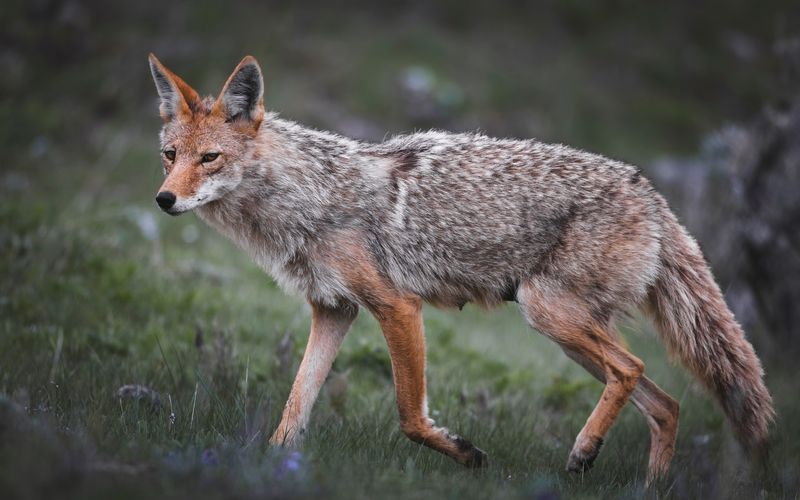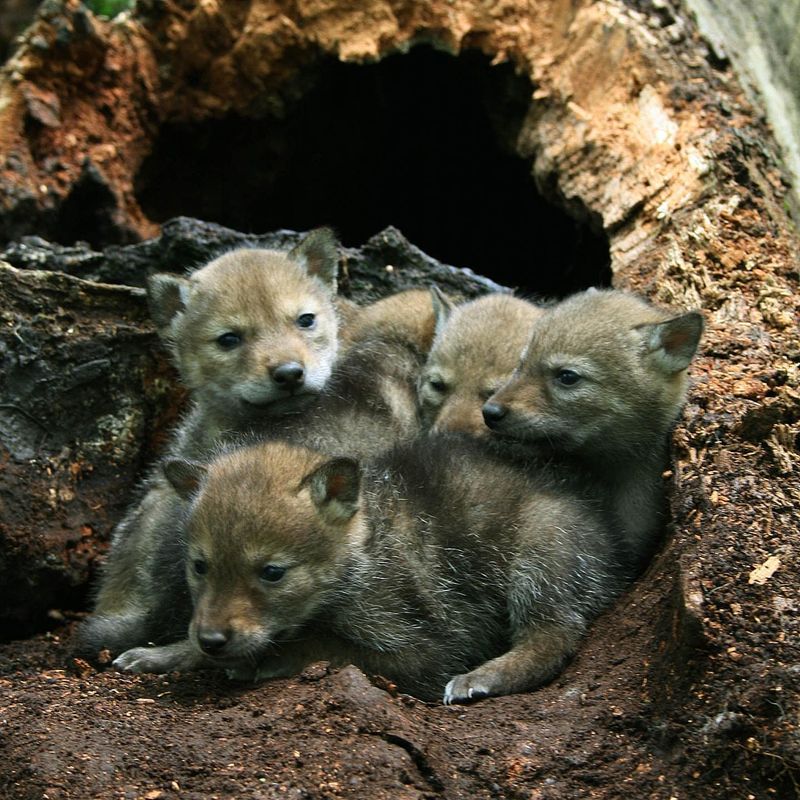Living in Nevada means coexisting with wildlife, and few animals are as adaptable—or as clever—as the coyote. As drought and development reshape their habitat, these wild canines are showing up more often in suburban yards. It’s a reminder that nature is never far away.
Spotting a coyote near your vegetable garden or fruit trees might feel alarming, but it’s not uncommon. These animals are drawn to food sources and quiet spaces. Knowing how to respond calmly and wisely helps keep both you and the coyote safe.
Setting clear boundaries—like securing trash, fencing gardens, and avoiding feeding wildlife—goes a long way. It’s not just about safety; it’s about respect. When we understand their behavior, we can share the landscape without conflict.
1. Make Yourself Look Bigger
Raising your arms and standing tall makes you appear more intimidating to a curious coyote. I’ve found waving my garden rake overhead works wonders when one was eyeing my tomato beds last summer.
The goal isn’t to harm the animal but to establish dominance. Coyotes in Nevada typically avoid confrontation with larger threats, preferring to retreat to safer territory.
My neighbor successfully scared off a persistent coyote by simply opening his jacket wide while making himself appear larger near his raised garden beds.
2. Create Loud Noises To Scare Them Away
Banging pots together creates a startling sound that sends most coyotes running. For me, keeping an old metal watering can and lid near my garden shed has proven useful during several unexpected visits.
Coyotes have sensitive hearing, making loud, unexpected noises particularly effective. Air horns work exceptionally well if you have children or pets playing near areas where coyotes have been spotted.
After a coyote started frequenting the fruit trees along my back fence, attaching aluminum cans to my garden gate created a makeshift alarm system that’s kept them at bay.
3. Maintain Eye Contact While Backing Away
Never turn your back on a coyote—they might interpret this as an opportunity to advance. While pruning my desert willow last spring, I encountered one near my compost bin and kept my eyes locked on it while slowly retreating.
The steady gaze communicates confidence and dominance. Moving deliberately backward toward safety gives the animal space to escape without feeling cornered among your garden beds.
Remember to breathe normally and move steadily. Quick movements might trigger the coyote’s chase instinct, especially if it’s near your vegetable patch or irrigation lines.
4. Secure Your Garbage And Compost
Coyotes love investigating open compost piles, especially those containing fruit scraps from my orchard. Since switching to a secure tumbler composter, nighttime visitors have significantly decreased around my vegetable garden.
Food waste attracts these opportunistic hunters to residential areas. Wildlife experts from the Nevada Department of Wildlife often cite unsecured trash as the number one reason coyotes venture into neighborhoods.
Consider installing motion-activated sprinklers near your garden waste area. My gardening club friend swears this tactic saved her heirloom tomatoes from becoming collateral damage during coyote visits.
5. Install Motion-Activated Lights Around Garden Areas
Sudden brightness startles these nocturnal visitors away from vulnerable areas. After installing solar-powered motion lights around my raised vegetable beds, midnight coyote explorations dropped dramatically.
Strategic placement matters tremendously. Focus on protecting entrances to your yard, pathways between garden sections, and areas where you’ve spotted coyote activity near your drip irrigation system.
For my xeriscape garden in northern Nevada, I positioned lights to illuminate both the native plant section and the fruit tree grove—two areas that previously attracted coyotes searching for rabbits and fallen fruit.
6. Remove Fallen Fruit From Your Orchard Area
Overripe peaches from my dwarf trees were attracting all sorts of wildlife until I established a daily cleanup routine. Fallen fruit creates an irresistible buffet that draws coyotes closer to your living spaces.
Maintaining a tidy orchard floor reduces incentives for these adaptable predators. My gardening journal shows fewer coyote sightings during months when I’m diligent about fruit cleanup compared to busier periods when I’ve let it slide.
Consider installing fruit catchers under trees if daily pickup becomes overwhelming. This simple netting system has saved my back while keeping my Nevada yard less appealing to hungry coyotes.
7. Protect Small Pets With Coyote-Proof Fencing
After my neighbor’s chihuahua had a close call, I reinforced my garden fence with roll bars and buried hardware cloth to prevent digging. Coyotes can easily clear standard fences or exploit gaps near garden beds.
Effective barriers need to be at least six feet tall with coyote rollers on top. The underground barrier should extend at least 12 inches deep around vegetable gardens and pet areas.
For my desert landscaped yard in Las Vegas, combining physical barriers with strategic placement of native Nevada plants like prickly pear and agave created natural deterrents while maintaining our region’s aesthetic.
8. Report Repeated Sightings To Nevada Wildlife Services
When the same coyote started appearing daily near my raised vegetable beds, I contacted our local wildlife office. Authorities track problem animals and can provide specialized assistance when needed.
The Nevada Department of Wildlife offers excellent resources for homeowners dealing with persistent wildlife issues. Their experts suggested modifications to my drip irrigation system that was creating small puddles attracting rodents—and subsequently, coyotes.
Keep a log of sightings, noting times and behaviors. My garden journal entries helped officials identify a pattern related to my neighbor’s unsecured chicken coop that was ultimately resolved.
9. DON’T Feed Coyotes Under Any Circumstances
A well-intentioned neighbor once left meat scraps near her compost pile, creating a wildlife disaster for our entire street. Feeding creates dangerous habituation that’s nearly impossible to reverse.
Once coyotes associate humans with food, they lose their natural wariness. This leads to bold behavior around garden spaces and increased risk to pets and children playing near vegetable patches.
Even indirect feeding—like unsecured bird feeders attracting rodents—can create problems. I redesigned my native plant garden to minimize unintentional food sources while still supporting local Nevada pollinators.
10. DON’T Run Away From A Coyote
My instinct to sprint toward my garden shed when spotting a coyote by my raised beds was completely wrong. Running triggers their chase response—a dangerous situation that escalates quickly.
Moving deliberately communicates confidence rather than prey behavior. While harvesting vegetables from my drought-resistant garden last fall, I encountered a coyote and remembered to back away slowly while maintaining eye contact.
Keep gardening tools nearby that could help you appear larger. My cultivator rake serves double duty—breaking up Nevada’s clay soil and as a deterrent when held overhead during unexpected wildlife encounters near my fruit trees.
11. DON’T Approach Coyote Dens Or Pups
Discovering a den beneath my garden shed was fascinating but potentially dangerous. Mother coyotes become extremely protective of their young, especially during spring whelping season in Nevada.
Give wide berth to any area where you suspect denning activity. When planning my native plant garden expansion, I completely avoided the corner where I’d spotted pups playing near my compost area the previous season.
If you notice increased coyote activity around specific garden zones, consider temporarily abandoning those areas. Last year, I shifted my vegetable harvesting schedule to avoid twilight hours when the local coyote family was most active.

